Last Monday, we were in the midst of ex-hurricane Ophelia. Now we are recovering from storm Brian.
For many farmers, Brian will have longer-lasting repercussions than Ophelia because while Ophelia was extremely windy, it didn’t bring near as much rain as Brian.
Damage to buildings and power outages aside, very heavy rain is worse than wind. Many herds had to be housed on Friday and have been housed since because ground is just too wet.
For those not already housed, it will spell the end of grazing for 2017 and a long winter looms. For others, a chance to resume grazing, if even for a short time, should present itself during the week, as drier weather is forecast.
At this stage, it’s going to be about grabbing chances when they come.
On/off grazing is the order of the day, along with back-fencing and grazing in square blocks.
Target the targets
Don’t lose sight of grazing targets. At this stage, you should have 50% of the farm closed. Over the next seven days, you should aim to get up to 60% or 70% grazed and closed.
But percentage grazed is secondary to average farm cover. Target average farm cover at closing should be 600kg/ha to 700kg/ha. This will allow an opening farm cover of between 900kg and 1,000kg/ha, depending on winter growth.
Whatever about grazing in the autumn, the priority must be grazing in the spring, as spring grass is far more valuable.
For herds that are housed, feeding good-quality silage is important to keep yields up, but remember that some good bales will be required next spring too. So just like with grass, keep enough in reserve for the spring.
Clean down cubicles twice a day and lime once a day to reduce risk of mastitis. SCC is likely to rise now that cows are in sheds and yield is falling.
Read more
Unsung hero: the farmer who milked 11 herds in one day by donating his generator
Dairy markets: renewed milk output dampens sentiment
Last Monday, we were in the midst of ex-hurricane Ophelia. Now we are recovering from storm Brian.
For many farmers, Brian will have longer-lasting repercussions than Ophelia because while Ophelia was extremely windy, it didn’t bring near as much rain as Brian.
Damage to buildings and power outages aside, very heavy rain is worse than wind. Many herds had to be housed on Friday and have been housed since because ground is just too wet.
For those not already housed, it will spell the end of grazing for 2017 and a long winter looms. For others, a chance to resume grazing, if even for a short time, should present itself during the week, as drier weather is forecast.
At this stage, it’s going to be about grabbing chances when they come.
On/off grazing is the order of the day, along with back-fencing and grazing in square blocks.
Target the targets
Don’t lose sight of grazing targets. At this stage, you should have 50% of the farm closed. Over the next seven days, you should aim to get up to 60% or 70% grazed and closed.
But percentage grazed is secondary to average farm cover. Target average farm cover at closing should be 600kg/ha to 700kg/ha. This will allow an opening farm cover of between 900kg and 1,000kg/ha, depending on winter growth.
Whatever about grazing in the autumn, the priority must be grazing in the spring, as spring grass is far more valuable.
For herds that are housed, feeding good-quality silage is important to keep yields up, but remember that some good bales will be required next spring too. So just like with grass, keep enough in reserve for the spring.
Clean down cubicles twice a day and lime once a day to reduce risk of mastitis. SCC is likely to rise now that cows are in sheds and yield is falling.
Read more
Unsung hero: the farmer who milked 11 herds in one day by donating his generator
Dairy markets: renewed milk output dampens sentiment






 This is a subscriber-only article
This is a subscriber-only article










SHARING OPTIONS: